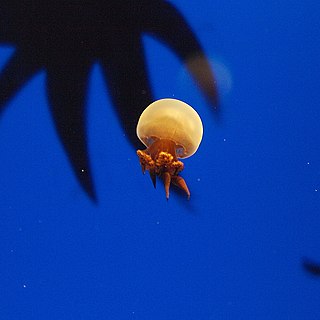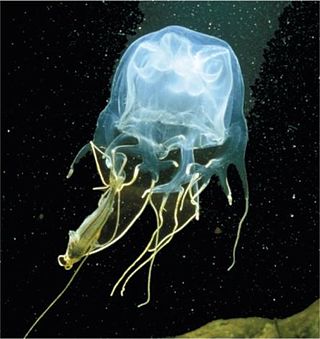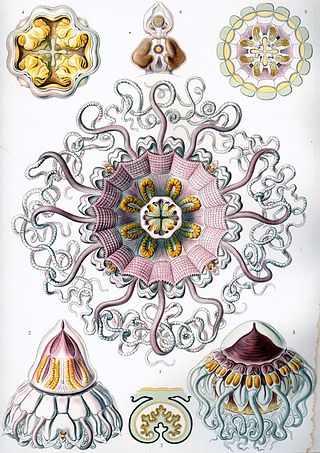
Rhizostomeae is an order of jellyfish. Species of this order have neither tentacles nor other structures at the bell's edges. Instead, they have eight highly branched oral arms, along which there are suctorial minimouth orifices. These oral arms become fused as they approach the central part of the jellyfish. The mouth of the animal is also subdivided into minute pores that are linked to coelenteron.

Crown jellyfishes are the six families of true jellyfish that belong to the order Coronatae. They are distinguished from other jellyfish by the presence of a deep groove running around the umbrella, giving them the crown shape from which they take their name. Many of the species in the order inhabit deep sea environments.

Linuchidae is a family of crown jellyfish.

Rhopilema is a genus of jellyfish.

Stomolophus is a genus of true jellyfish from the West Atlantic and Pacific. It is the only genus in the monotypic family Stomolophidae. Formerly, Nomura's jellyfish was also included in this genus, but has now been reclassified to the family Rhizostomatidae.

Atolla is a genus of crown jellyfish in the order Coronatae. The genus Atolla was originally proposed by Haeckel in 1880 and elevated to the monotypic family level, as Atollidae by Henry Bigelow in 1913. The six known species inhabit the mesopelagic zone. The medusae possess multiple lobes called lappets at the bell margin. Medusae also have eight tentacles, alternating with eight rhopalia, and twice as many lappets occur as tentacles.

Monera is historically a biological kingdom that is made up of prokaryotes. As such, it is composed of single-celled organisms that lack a nucleus. It has been superseded by the four-kingdom system.

Alatinidae is a family of box jellyfish within class Cubozoa, containing the following genera and species:

Lucernariidae is a family of stalked jellyfish containing two genera.

Limnomedusae is an order of hydrozoans.

Rhizostomatidae is a family of cnidarians in the class Scyphozoa.

Catostylus is a genus of jellyfish in the family Catostylidae.

Alatina is a genus of box jellyfish within class Cubozoa. It is the largest of the three known genera in the family Alatinidae, and the only one which is not monotypic. It contains the following ten species:

Chirodropus is a genus of box jellyfish in the family Chirodropidae.

Coronamedusae is a subclass of jellyfish in the class Scyphozoa. It is the sister taxon of Discomedusae and contains about 50 named species, all included in the order Coronatae. Jellyfish in this subclass are either small medusae living in shallow marine environments, or large medusae living in the deep sea.

Linuche aquila is a species of cnidarian found in the tropical and subtropical areas of the Pacific Ocean. It is very small and is commonly known as a thimble jellyfish because of its size and shape. The larvae can cause bathers to develop an itchy red rash commonly known as seabather's eruption.
Linantha is a genus of crown jellyfish in the family Linuchidae. It is a monotypic genus and the only species is Linantha lunulata which was first described by the German biologist Ernst Haeckel in 1880. It is found in the tropical eastern Pacific Ocean in the vicinity of the Galápagos Islands.

Thysanostomatidae is a family of true jellyfish from the Indo-Pacific. The first sighting of Thysanostoma loriferum in Hong Kong; extending its known range from the Philippines, the Malay Archipelago, and Hawaii; was from the Hong Kong Jellyfish Citizen Science project and sightings on iNaturalist.
Lucernaria is a genus of cnidarians belonging to the family Lucernariidae.
Codonium is a genus of hydrozoans belonging to the family Corynidae.
















